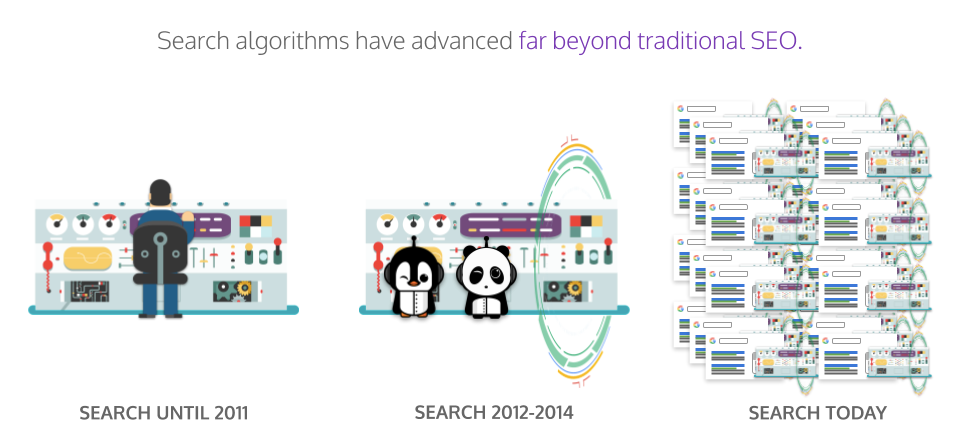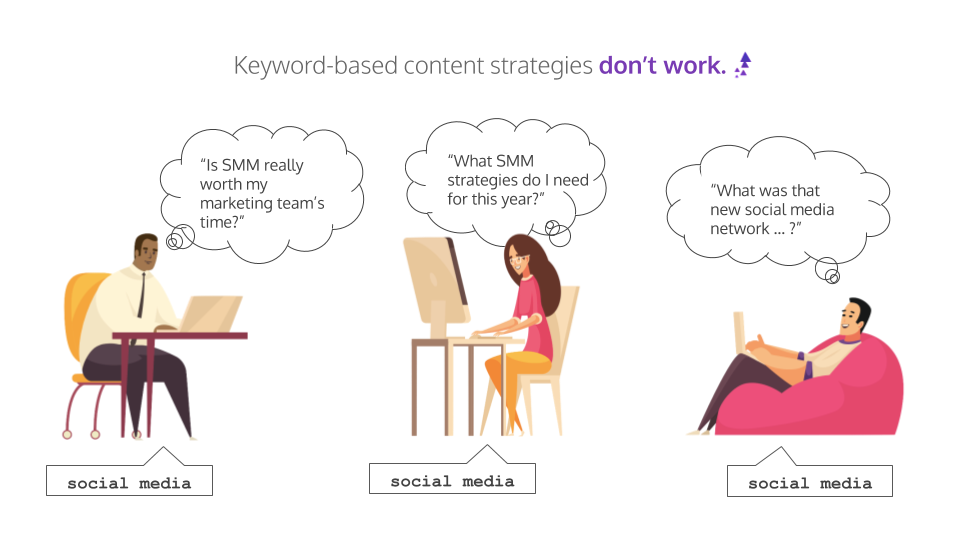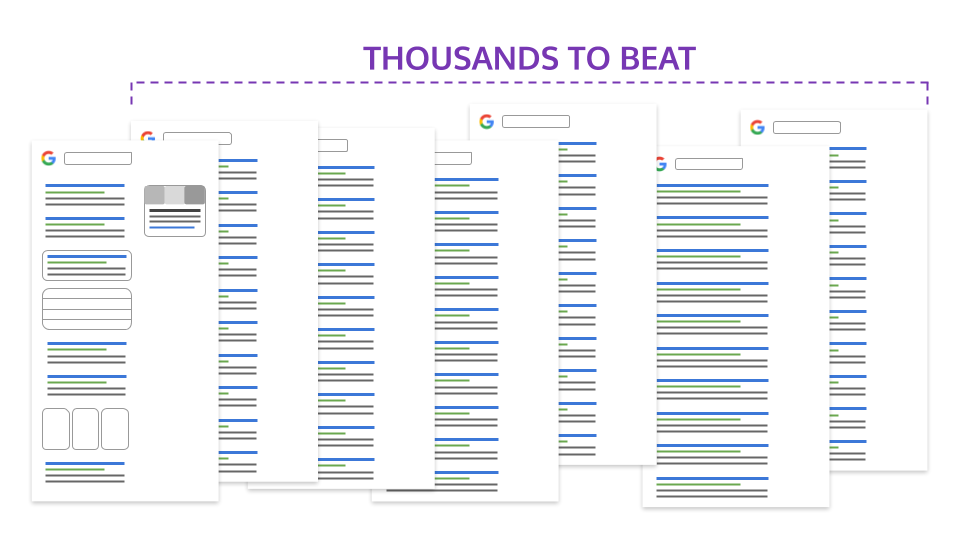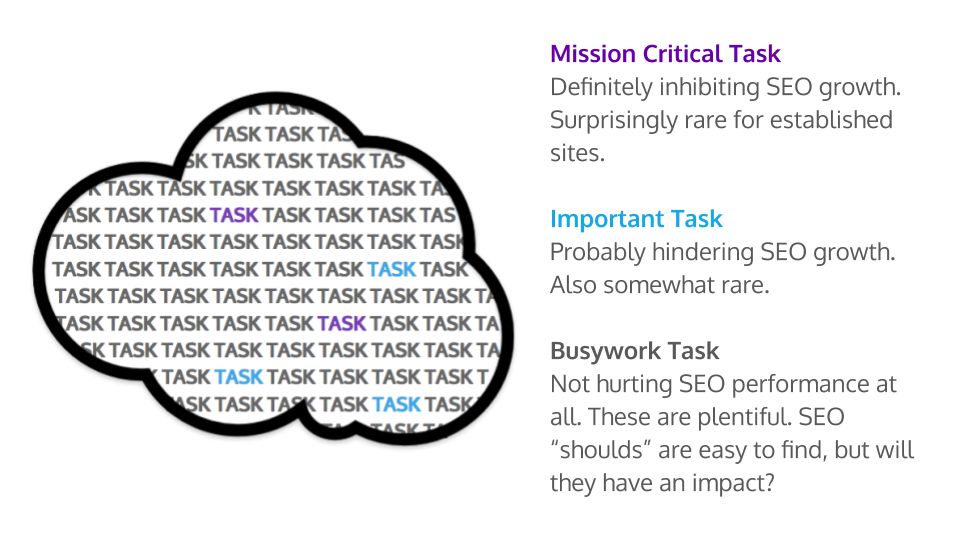A Modern Framework for SEO Work that Matters
Traditionally, SEO meant trying to figure out and “optimize” for Google’s algorithm and the ranking factors that mattered most. If you got your site just right for Google, you were rewarded with higher rankings.
But today, Google’s artificial intelligence-infused algorithm is constantly changing, responding every moment to its users. Google has algorithms teaching algorithms, with petabytes of data, to deliver the most useful content—which means traditional, one-size-fits-all SEO no longer works.

The only approach to SEO that delivers results is one that delivers the most helpful website/content (while meeting baseline SEO needs).
Profound Strategy’s modern SEO framework is both sustainable and high-impact. It’s not built on ranking factors that change with every Google update, but on fundamentals that matter (and that will continue to matter, far into the future)
At a high level, the framework addresses baseline SEO needs, which are primarily technical in nature and are necessary to earn any rankings. Most importantly, Profound Strategy’s framework provides a clear view of the tactics and strategies that deliver predictable, reliable, and scalable SEO growth.
Growth SEO: The Way to Compete and Win
We’ve spent 10 years critically examining SEO strategies to identify the ones that produce reliable, scalable growth. There are many tactics that used to work, such as: putting target keywords in all the right places, creating internal links, maintaining an authoritative domain, and building inbound links. There also are the foundational, or baseline, SEO tactics mentioned later in this article.
Only one tactic still delivers reliable, predictable, scalable SEO growth: Content that is built on competitive organic research and designed to be better than the top-performing URLs winning in search today.
Better-Than-Best Content Starts with the User’s Need
With its advanced, machine learning algorithms, Google is no longer tricked by quick-win tactics such as a keyword density ratio or a bunch of low-quality backlinks. Only the best of the best content earns meaningful organic traffic.
Google’s algorithm now looks at metrics that we don’t see, making it impossible to create new content “optimized” around those factors. Instead, we create content focused not on a single keyword, but on a user need.
What’s the difference?
A user need is a specific need that a user has, at a specific point in the buyer’s journey, that inspires an organic search.
A user need may be associated with many keywords, because many users type a variety of phrases into a search bar to ask the same basic question.
So creating content around a single keyword may or may not be helpful to a user; but creating content around a user need necessarily produces an extremely helpful piece of content focused on the user.

Creating Better-Than-Best Content Based on User Need
There are always three to five URLs for each user need—across all the keywords associated with that need—that earn 90%+ of the search traffic. Those URLs are what Google has determined are the “best” pieces of content to address the user need.
In order to win, and drive organic traffic, a marketer must create content that is superior to, and more helpful than, the current “winners” on the SERP.
How do you do this? Study those URLs with the winning content. Analyze that content to understand what the winners are doing and what questions the content answers for the user. Look at SERPs for queries that produce similar results, and identify who is winning in the organic space for that topic/conversation.’
Then, identify common threads in the winning content:
- What are the winners doing?
- Is the content long or short?
- Informative or sales-oriented?
- Do they include images? Tables? Video? Graphs?
- Is it timely, or evergreen?
- What are some common subtopics?
Outline a foundation for your content based on insights from organic search research, and then go above and beyond. Include your brand’s unique insights and value. Combine subtopics from the top three to five winners into one complete resource. You may also be able to improve on the UX, images, etc.
The Content Quantity vs. Quality Question
Every SEO content project struggles with the question of quantity vs. quality, trying to balance the amount of content against the quality of that content.
A high-volume approach can be successful; we’ve investigated many sites with huge amounts of content. Some of that content does very well, but it’s usually a small percentage of the overall content.
For example, a marketer who spends $1,000 on 100 pieces of mediocre content might get one page that performs well. That’s essentially spending $1,000 on one piece of content.
Think of this approach as throwing spaghetti on the wall to see what sticks. It works—to an extent—but the resulting ROI is low, and most marketers don’t have the budget to produce huge volumes of low-ROI content. Marketers used to do this because they didn’t know what would work. But now we do know what works, so we can be much more targeted and create a consistently higher ROI.
And whatever you’re writing about, the fact is that thousands of articles already exist about that subject. Is your content really better than all of those?

Baseline SEO: Get Into the Game
The important thing to know about a modern SEO framework is that not all technical SEO is created equal. Every SEO task does not create meaningful results.
So which technical SEO factors are meaningful prerequisites to good rankings, and which technical SEO tasks are mere busywork?

Mission Critical and High Priority Issues
“Baseline SEO” refers to the technical SEO tactics necessary to get a website to a place where it can begin to compete in organic search. Left unaddressed, these items can prevent any content (even the very best) from ranking.
What kind of technical SEO issues must always be addressed?
- Issues that prevent a site or certain pages from being indexed. If Google can’t crawl the content, it can’t rank the content.
- Issues that cause a site to load slowly. Google has made site speed a key factor in rankings. There is no specific guidance as to what speed metrics a site needs to attain, and studies of top ranking content have not provided a hard number either. The best guidance we have is that websites should load “reasonably fast” for desktop and mobile users. If GTMetrix says it takes a site more than 10 seconds to load, site performance needs work. An ideal load time is two to five seconds.
- Mobile usability and UX issues. Google has also made mobile-friendliness a priority in rankings. If a site has mobile UX issues or is just plain difficult to use on mobile, it will likely have a very difficult time ranking—even if most of the users are on desktop.
- User experience and visual design. Websites that have significantly outdated, or simply “bad,” design will have a hard time earning rankings. That is primarily because users prefer up-to-date designs. The characteristics of “modern” design is, by definition, always changing. A better site design may not necessarily increase rankings directly, but marketers must ensure that their site designs are generally up-to-date and visually appealing if they want to compete in organic search.
Trivial Technical SEO Items
Not every technical SEO task is worth doing. After addressing the mission critical/high-priority tasks, think carefully about how much time and effort to spend on anything else.
Even traditional best practices can be exercises in futility, because minor technical adjustments don’t create SEO gains anymore. The importance of some SEO items are still subject to disagreement, even among professionals.
For example:
- Adding keywords — Many SEO writing tools are built around the premise that content needs to use the target keyword multiple times and in certain places. The phrase “optimize content for SEO” has become nearly synonymous with “add keywords all over the place.”
News flash: Google doesn’t need a particular ratio of exact keywords to figure out what a piece of content is about anymore. Google’s algorithms have been smarter than that for years, and the Penguin update in 2012 specifically downranks content suspected of keyword stuffing.
- Cleaning up 404s — It’s often assumed that every URL should be 301 redirected when its content is deleted, but Google specifically says we shouldn’t always 301 the deleted content. Rather, a 404 page is appropriate for a deleted URL that has no appropriate replacement.
A technical SEO audit can result in numerous trivial SEO items which can at times include:
- Add logo schema markup
- Improve page speed by .0001 seconds
- Redirect all possible homepage variations
- Adjust meta description length
- Disavow backlinks, even when there’s no manual penalty
- Rearrange headline tag markup regardless of visual appearance
- Optimize broken, deprecated, or useless pages
That’s not to say that these examples are always trivial. In certain circumstances, they may be a true hindrance to SEO growth. However, in our experience, in most instances, these items have no impact on SEO traffic once implemented.
Marketers devote a lot of time and resources to trivial SEO work because many trivial tasks are wrapped in language that make them seem far more important than they are. For example, most SEO tools generate a list of “errors” for a site audit. No one wants errors on their site, so it creates a sense of emergency where there really isn’t any.

So before taking action on another SEO item, ask yourself (or your SEO agency) the following questions:
- Is this a ‘must have’? Why?
- Is it an example of any of the “mission critical” items mentioned above?
- When or how have you seen this specific work lead to organic growth in the past?
Ultimately you must know: Will this item, without doubt, lead to SEO traffic growth in the next two to three months? If the answer is anything other than a resounding “Yes,” then there is a good chance the work may be trivial.
It is not easy, but don’t waste resources on technical SEO that won’t produce growth and ROI. Instead, focus on creating content better than all of your direct competitors. That’s where the growth comes from.
Growth SEO for the Win
Growth SEO means investigating the top-ranked content, understanding exactly what that content is doing, and understanding why that content resonates with users more than the hundreds or thousands of other options. Only then can you systematically create content that’s better than the best existing content.
We call this better-than-best content certified content, and our team is trained to produce it repeatedly. Certified content consistently achieves growth in organic traffic and outranks competitors. It gets beyond the limitations of keyword-based content and technical SEO items which, as we discussed earlier, get you inside the front door of Google, but fail to deliver growth.
Profound Strategy’s streamlined process of research, investigation, and our certified content is designed to deliver SEO growth reliably, predictably, and repeatedly, so our clients can win. Learn more about how we do it with our Modern Guide to High-Impact SEO Content, or chat with one of our solutions experts to see how we can tailor a strategy to your brand.
What's Next?
Profound Strategy is on a mission to help growth-minded marketers turn SEO back into a source of predictable, reliable, scalable business results.
Start winning in organic search and turn SEO into your most efficient marketing channel. Subscribe to updates and join the 6,000+ marketing executives and founders that are changing the way they do SEO:
And dig deeper with some of our best content, such as The CMO’s Guide to Modern SEO, Technical SEO: A Decision Maker’s Guide, and A Modern Framework for SEO Work that Matters.




